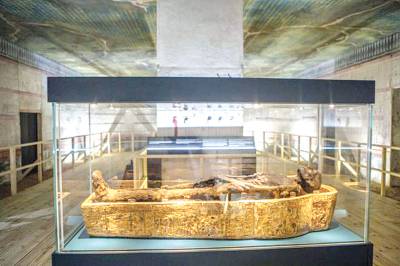https://nation.com.pk/03-Feb-2019/the-women-who-love-mummies
The women who love mummies

Egypt - Women explorers played a major part in the UK's fascination with Egyptian mummies a century ago, and girls who - much later - visited their collections in provincial museums are among today's up-and-coming archaeologists. Samira Ahmed looks at female influence in the mummy world. It was a "light bulb moment - like being teleported back into ancient Egypt" says Danielle Wootton, remembering her excitement at seeing Bolton Museum's Egyptian mummy for the first time."
Suddenly there were these people that lived hundreds of years ago and in a very different way to how I lived my life in Bolton. It was just amazing to think that this other world existed, this past - who were these people and what kind of language did they speak?" In time Danielle became a professional archaeologist and an expert on Channel 4's Time Team.
Later, the same thing happened in Macclesfield, 30 miles to the south, when Rebecca Holt walked into the city's West Park Museum and saw the mummy case of a 15-year-old temple girl.
"I was probably about five and remember seeing the mummy case for the first time and it was just sheer fascination. 'Mum, what's this, what's this?' And my fascination never went away," she says.
She kept going back and at 14 was a museum volunteer, spending hours there after school. A mentor, honorary curator Alan Hayward, taught her how to read hieroglyphs and handle objects. Now 24, she's just finished a master's degree in archaeology at Oxford University. The passions awakened by the mummies in these two young women are inherited in a very direct way from two women who lived in their localities a century earlier, and whose collections the museums were built to house - Annie Barlow in Bolton and Marianne Brocklehurst in Macclesfield.
In fact, there is an even stronger link than this between Danielle Wootton and Annie Barlow. Barlow was the daughter of a wealthy mill-owner, and Danielle's own grandmother and aunt worked in the Barlow and Jones family mills.
It was the money earned from the mill - which spun Egyptian cotton into Lancashire cloth - that enabled Barlow to go and explore Egyptian tombs. Marianne Brocklehurst, meanwhile, came from a silk manufacturer's family. As well as funding her own travels she paid out of her own pocket for the construction of the West Park Museum, where Rebecca found her inspiration. Her legacy includes not just the objects she brought back from Egypt but her detailed diaries and sketches of her trips down the Nile, which are some of the only records of tomb sites before they were disturbed.
But there is a third northern mill heiress who made a major contribution to the UK's mummy mania - Amelia Oldroyd, whose finds are catalogued in leather-bound record books in the archive of the Bagshaw Museum in Batley. She was one of the first to explore a burial chamber at Abydos - now recreated in the museum - after it was opened in 1900 for the first time in 4,000 years. At a time when male collectors were throwing textiles aside in their hunt for large mummy cases and gold objects, Amelia brought back a rare intact cartonnage - a mummy wrapping made of papyrus with a painted representation of the dead person's face.
She points also to their collections of cartonnage face wrappings. "There is this intimacy in the mummy face. You can see the eyes, it's looking back at you. You can see the human being in there." In the present day, Danielle and Rebecca also focus on small portable antiquities and what they reveal about lived life - the make-up containers, the jewellery, the small statues. Rebecca's favourite object in the display in Macclesfield is a six-inch statuette of a queen, Queen Ti, who is wearing large ornate wig and carrying a lotus flail. "It's one of the first artefacts whose hieroglyphs I tried to translate, so that's quite special to me," she says. "The carving itself is really magnificent. I love Queen Ti - how powerful she was and how much influence she had."
For Heba, 26, who grew up looking at the pyramids and thinking about the human labour forced to create them, while reading books on the ancient Egyptian world bought for her by her father the Victorian women themselves hold a complex fascination. They were Egyptology pioneers, who used public subscription to fundraise to bring cultural enrichment back to ordinary people. But they were also colonial looters.
-- Sent from my Linux system.
No comments:
Post a Comment